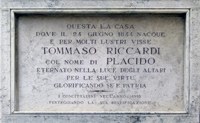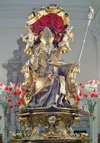

St Emilianus of Trevi (28th January)
St Emilianus was arrested and tortured in an attempt to force him to renounce his faith. He was tortured and the tied to an olive tree at a place outside Civitas Lucana called Carpiani, where he was beheaded. This was probably at modern Bovara, the site of an ancient olive tree that is traditionally associated with the execution of St Emilianus.
SS Vincent and Benignus (6th June)
Relics were returned from Lucca to Trevi in 1703, an event commemorated by the commission of this fresco outside Palazzo Comunale, Trevi. It depicts the Madonna and Child with St Emilianus, the patron saint of Trevi, and SS Vincent and Benignus.
Blessed Ventura (11th July)
Ventura was born in 1250 at Pissignano, which then belonged to Trevi. He became a hermit and was widely venerated in the Vale of Spoleto. He was mentioned in the process of canonisation of St Clare of Montefalco (1308) because he had prophesied that she would be sanctified. He died in 1310 and was buried in a Roman sarcophagus the Franciscans' church in Trevi, which was rededicated in his honour.
The Franciscans rebuilt their church in 1354, and the relics and their sarcophagus were translated to its high altar, probably as soon as it was ready to receive them. The church was re-dedicated as San Francesco in 1477 and the relics of the Blessed Ventura remained largely forgotten until they were re-discovered when the high altar was demolished in 1593, at which point:
-
✴Muzio Petroni arranged for the translation of the relics to his chapel to the right of the apse, where they were interred in a new sarcophagus in which he also enclosed a copy of the account of the life of the Blessed Ventura that he had written; and
-
✴the original Roman sarcophagus was moved to the counter-facade.
Recent Saints

-
✴Blessed Peter Bonilli, who was the parish priest of Cannaiola, near Trevi from 1863 until 1898, when he moved to Spoleto, and who is therefore described in the pages on saints of Spoleto; and
-
✴two men described below:
-
•Blessed Placid Riccardi and
-
•St Antony Fantosati.
Blessed Placido Riccardi (15th March)

The inscription on a house near Sant’ Emiliano records that Tommaso Riccardi was born here in 1844 (see the Walk around Trevi). He became a monk at San Paolo Fuore le Mura, Rome. It was here that he took the name Placido. He was arrested as a deserter in 1870 when he tried to avoid military service, and had to spend a short time in the army thereafter.
He served as chaplain on the nuns of San Magno, Amelia in the period 1877-87. (This nunnery was dependent upon San Paolo Fuore le Mura). He then moved to the Abbazia di Farfa, where he spent the next twenty years as rector. He presided over the rejuvenation of monastic life at the abbey and was venerated by the local people. When he became paralysed in 1915, he returned to San Paolo fuore le Mura to die. Pope Pius XII beatified him in 1954 and his body was returned to Farfa in 1957.
St Antony Fantosati (4th July)
St Antony was born near Trevi and baptised in Sant’ Emiliano in 1842. He joined the Franciscan Order and became a missionary in China in 1867. He was ambushed and murdered with a number of colleagues in 1892, during the Boxer Uprising. He was among the 120 "martyrs of China" who were canonised in 2000.
Return to the home page on Trevi.



